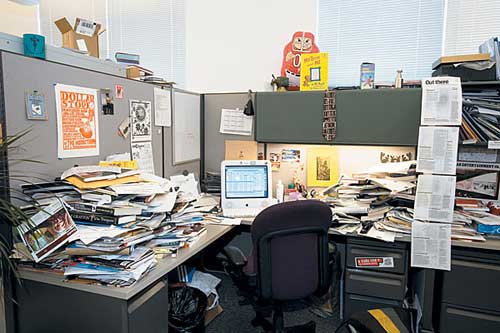Brewer & Treyens (1981)
 Brewer & Treyens carried out a classic study of the role of schema in memory. You can use this study for the following topics:
Brewer & Treyens carried out a classic study of the role of schema in memory. You can use this study for the following topics:
Theories of one cognitive process.
Schema theory.
Reconstructive memory
The original study is available here.
The aim of the study was to investigate the role of schema in encoding and retrieval of episodic memory. The basic assumption of schema theory is that individuals' prior experience will influence how they remember new information.
The sample was made up of 86 university psychology students. Participants were seated in a room that was made to look like an office. The room consisted of objects that were typical of offices: a typewriter, paper, and a coffee pot. There was also a table with tools and electronics. There were shelves along one wall and then the other walls were decorated with posters and a calendar. There were some items in the room that one would not typically find in an office - for example, a skull or a toy top. Finally, there were items that were omitted - such as books.
Each participant was asked to wait in the professor's office while the researcher "checked to make sure that the previous participant had completed the experiment." The participant did not realize that the study had already begun. The participants were asked to have a seat. All of the chairs except for one had objects on them. In this way, it was guaranteed that all participants would have the same vantage point in the office. The researcher left the room and said that he would return shortly.
After 35 seconds the participants were called into another room and then asked what they remembered from the office. When they finished the experiment, they were given a questionnaire. The important question was "Did you think that you would be asked to remember the objects in the room. 93% said "no."
30 participants carried out written recall and then verbal recognition; 29 participants carried out drawing recall; 27 carried out verbal recognition only.
The recall condition: Participants were asked to write down a description of as many objects as they could remember from the office. They were also asked to state the location, shape, size, and colour of the objects. They were asked to "Write your description as if you were describing the room for someone who had never seen it." After this, they were given a recognition test in which they were given a booklet containing a list of objects. They were asked to rate each item for how sure they were that the object was in the room. "1" meant that they were sure it was not in the room; "6" meant that they were absolutely sure it was in the room. The questionnaire consisted of 131 objects: 61 were in the room; 70 were not.
The drawing condition: In this condition, participants were given an outline of the room and asked to draw in the objects they could remember.
The verbal recognition condition: In this condition, the participants were read a list of objects and simply asked whether they were in the room or not.
They found that when the participants were asked to recall either by writing a paragraph or by drawing, they were more likely to remember items in the office that were congruent with their schema of an office - that is, the "expected items" were more often recalled. The items that were incongruent with their schema of an office - e.g. the skull, a piece of bark, or the screwdriver - were not often recalled. When asked to select items on the list, they were more likely to identify the incongruent items; for example, they didn't remember the skull when doing the free recall but gave it a 6 on the verbal recognition task. However, they also had a higher rate of identifying objects which were schema congruent but not in the room.
In both the drawing and the recall condition, they also tended to change the nature of the objects to match their schema. For example, the pad of yellow paper that was on a chair was remembered as being on the desk. The trapezoidal work table was recalled as a square.
It appears that schema played a role in both the encoding and recall of the objects in the office.
In the written recall condition, the average number of correct objects recalled was 13.5. The average number of "inferred" objects recalled was 1.13. The objects that were remembered that were not in the room were books (by 9/30), a filing cabinet (3/30), pens (1/30), a coffee cup (2/30), a telephone (1/30), a lamp (1/30), and curtains (1/30). The results do not indicate a high number of errors and do not explain why some recalled these objects yet others did not.
There is no way to verify the schema of the participants prior to the experiment, but the researchers did a pilot study by using a questionnaire with students to determine schema consistent objects.
There are ethical concerns about the deception used in the study. The participants had agreed to be in the study, but they were deceived about the true nature of the study and were not told when the experiment had actually begun. This was necessary to avoid demand characteristics.

 IB Docs (2) Team
IB Docs (2) Team
